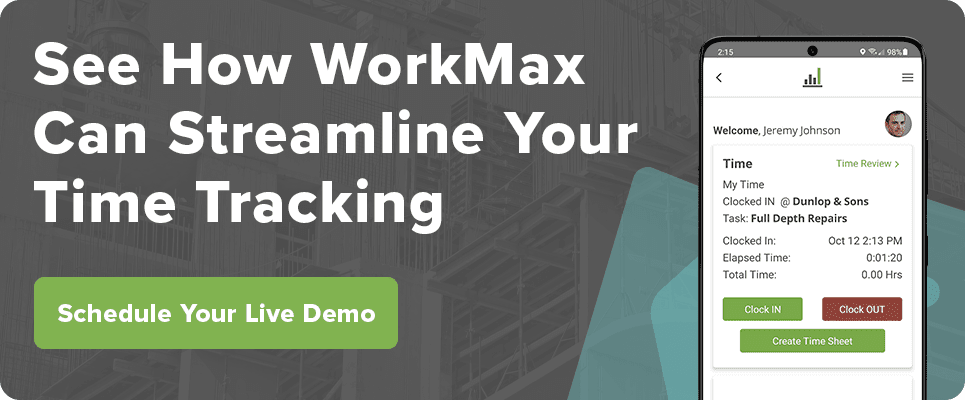Our users reported over 96% customer satisfaction for the last 10 years. Schedule a personal tour of our software to see how we can improve your business’s productivity.
Table of Contents
Share Article
How leveraging self-operating processes can save time and money, eliminate errors, and boost productivity.
It’s a known fact that the construction industry is under-automated. Heavily reliant on traditional analog methods, the industry at large ranks low on the digitization curve. The hang-ups are understandable.
After all, construction projects involve independent subcontractors and suppliers who all run their operations uniquely. Projects themselves vary significantly, making it difficult to develop effective tools and methods that can be applied across a firm’s job sites and office locations.
Nonetheless, by not taking advantage of digitization and automated systems for everything from time, safety, and equipment tracking to billing, construction companies are missing out on a substantial opportunity that is now technologically available to them.
Check out what data your construction equipment can tell you.

Automation, at its core, is designed to remove human intervention from processes. And, while often thought to outright subtract people from the equation, automation drives workforce productivity and increases growth opportunities.
“When employees hear digitization and automation, they sometimes think, ‘Oh, the office has given me more work to do in the field… They’re making me into a bookkeeper,’” said Christian Burger, president and founder of Burger Consulting Group. “That’s the one thing you hear the most from foremen in the field. They don’t want to be administrators. They want to be foremen, and they want to put work in place. So that’s one of the fears that you have to overcome.”
The 30-year industry veteran noted another fear he works to overcome when implementing automated systems: Being replaced. When there’s a feature that’s particularly powerful in a software that does the work employees are currently doing manually, people often jump to the conclusion that their job may no longer be relevant. But it really opens a new opportunity to reinvest time that saved time into higher-value tasks.
As the industry is being pushed into the digital age, here’s how workflow automation, using rule-based logic to automate manual work, can streamline processes and make workers more efficient:
What is a Field Data Workflow?
Workflows, in general, are a business process describing the specific actions that need to be carried out to properly and consistently complete a task. With automated workflows, one completed action leads to another, then to another, and so on, until the task is done. Automated workflows are like tracks guiding a train car.
At each stop, the train collects additional data, which propels the train further along the tracks, which ultimately leads it to its planned destination.
Specific to the construction industry are field data collection workflows that gather real-time project data throughout a shift, day, week, or even an entire project to provide management and other stakeholders updated information as the jobs progress from start to finish.
Why Should Contractors Automate Workflows?
Automated workflow solutions are built for an entire workforce, including office, mobile, and remote workers.
With a mobile workforce platform, companies can expedite field data collection and improve accuracy to boost project management capabilities. Such app-based platforms with automated workflow capabilities collect robust data throughout the day that’s shared between users and systems, giving supervisors and project managers accurate, real-time updates on what’s been completed on a project and how overall production is trending along the way.
Using automated workflows on a mobile workforce platform, construction companies can:
- Enter employee hours worked and provide multiple levels of approval
- Allocate labor hours to jobs/projects and tasks/cost codes in real time or after the fact
- Select which tasks or cost codes prompt employees to enter production
- Prompt employees to fill out required or optional forms on the clock in/out
- Present follow-up forms based on their responses to the previous form fields.
- Require employees to check in/out equipment on the clock in/out
- Restrict system equipment inventory access by job class for safety
- Enable custom lists to collect additional field data like per diem expenses or job classes
What Field Data Workflows Impact Project Performance KPIs?
With a mobile workforce platform, construction companies have the flexibility to set up customizable workflows that can apply to some or all of their employees to help expedite the collection of field data and ultimately help them achieve key business objectives. Here’s a look at the specific workflows that have a positive impact on project performance:
- Tracking Time and Tasks: Over the course of a shift, field employees need to clock in and out, allocate hours to a job or task, and get time approved by their supervisors. Utilizing a mobile workforce platform that’s integrated with automated workflows, workers can be prompted to select their next task or other required documentation step based on their prior selection. Once a field worker clocks in, automated workflows can track each task, the worker completes on that day until they clock out, giving project managers valuable insight into the progress of a project and the total time required to complete each activity.
- Keeping Projects on Schedule, Budget: With on-demand field data, project managers have critical insight into where a project stands as far as progress and budget go. Mobile workforce platforms integrated with ERP systems streamline data flow from the field to the office, syncing information on time tracking, completed work, and job costing to improve the accuracy of labor and job costs as well as field progress reporting. Live field data collection provides accurate live job costs to keep projects on track and on budget.
- Reducing Safety Risks: After clock-in, an automated workflow could prompt field workers to complete a health screening or provide them with workplace safety forms for some or all of your employees. The forms could also present training videos on safety protocols and require signature verification before employees can continue with their work for the day. At the end of the day, employees could be prompted with another health screening form that asks if they had adequate PPE equipment today or some other desired question(s). If they answered no, a follow-up form could be presented that could ask them what they needed and how many PPE items they would need the next day. This helps companies better care for and protect their most valuable assets – their people.
- Expediting Billing Processes: With any project billing for time and expenses or for hitting production milestones, automated workflows increase the accuracy and timeliness of billing. First, a customized workflow is set up to provide employees access to only jobs and tasks related to their job duties. Labor hours are collected in real time, and it’s easy for employees to allocate or assign those hours to the right project, task, or cost code. The labor hours by cost code are automatically synced with the ERP to issue invoices for billing. For companies that bill based on project milestones, unique workflows prompt employees to enter the units completed by cost code when they change to a new task or cost code or have completed their work for the day. This production data streams into the ERP to accurately capture how much work has been completed as it happens. Live field data integrated with an ERP system allows companies to bill accurately and promptly for time, expenses, and milestones.

Through the automation of these processes, companies can effectively manage projects and employees, streamline communications, increase employee accountability, improve worker productivity, expedite billing processes, and reduce human error. The right mobile workforce management systems make all of this possible.

